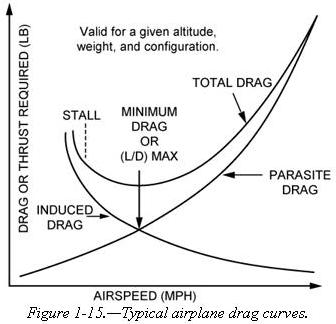Every part of the airplane which is exposed to the air while the airplane is in motion produces some resistance and contributes to the total drag. Total drag may be classified into two main types:

The propeller, acting as an airfoil, produces the thrust, or forward force that pulls (pushes) the airplane through the air. It receives its power directly from the engine, and is designed to displace a large mass of air to the rear. It is this rearward displacement that develops the forward thrust that carries the airplane through the air. This thrust must be strong enough to counteract the forces of drag and to give the airplane the desired forward motion. The direction of this thrust force is referred to as the thrust line.
| Drag is the rearward acting force which resists the forward
movement of the airplane through the air. Drag acts parallel to and in
the same direction as the relative wind.
Every part of the airplane which is exposed to the air while the airplane is in motion produces some resistance and contributes to the total drag. Total drag may be classified into two main types: |
 |
• Induced Drag
• Parasite Drag
Induced drag is the undesirable but unavoidable byproduct of lift, and increases in direct proportion to increases in angle of attack. The greater the angle of attack up to the critical angle, the greater the amount of lift developed, and the greater the induced drag. The airflow around the wing is deflected downward, producing a rearward component to the lift vector which is induced drag. The amount of air deflected downward decreases greatly at higher angles of attack; therefore, the higher the angle of attack or the slower the airplane is flown, the greater the induced drag.
Parasite drag is the resistance of the air produced by any part of the
airplane that does not produce lift.
Several factors affect parasite drag. When each factor is considered
independently, it must be assumed that other factors remain constant. These
factors are:
• The more streamlined an object is, the less the parasite drag.
• The more dense the air moving past the airplane, the greater the
parasite drag.
• The larger the size of the object in the airstream, the greater the
parasite drag.
• As speed increases, the amount of parasite drag increases.
| If the speed is doubled, four times as much drag is produced.
Parasite drag can be further classified into form drag, skin friction, and interference drag. Form drag is caused by the frontal area of the airplane components being exposed to the airstream. A similar reaction is illustrated by figure 1-14, where the side of a flat plate is exposed to the airstream. This drag is caused by the form of the plate, and is the reason streamlining is necessary to increased airplane efficiency and speed. Figure 1-14 also illustrates that when the face of the plate is parallel to the airstream, the largest part of the drag is skin friction. |
 |
Skin friction drag is caused by air passing over the airplane’s surfaces
and increases considerably if the airplane surfaces are rough and dirty.
Interference drag is caused by interference of the airflow between adjacent
parts of the airplane such as the intersection of wings and tail sections
with the fuselage. Fairings are used to streamline these intersections
and decrease interference drag.
 |
It is the airplane’s total drag that determines the amount of thrust
required at a given airspeed. Figure 1-15 illustrates the variation in
parasite, induced, and total drag with speed for a typical airplane in
steady, level flight. Thrust must equal drag in steady flight; therefore,
the curve for the total drag also represents the thrust required.
Also note in figure 1-15, that the airspeed at which minimum drag occurs is the same airspeed at which the maximum lift-drag ratio (L/D) takes place. At this point the least amount of power is required for both maximum lift and minimum total drag. This is important for determining maximum endurance and range for the airplane. The force of drag can be controlled to a certain extent by the pilot. Loading the airplane properly, retracting the landing gear and flaps when not used, and keeping the surface of the airplane clean, all help to reduce the total drag. |